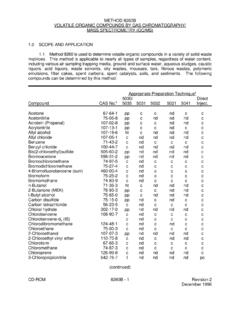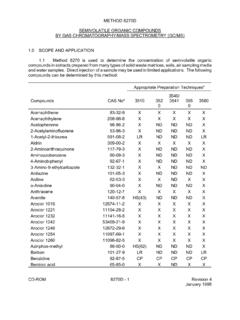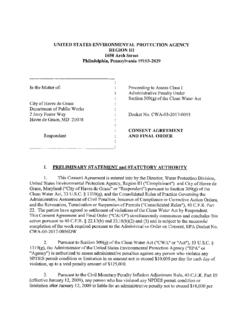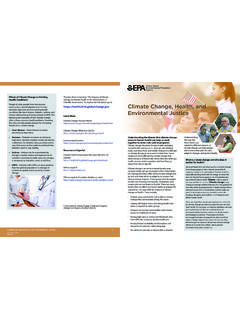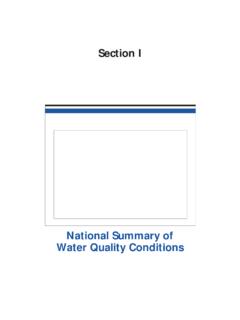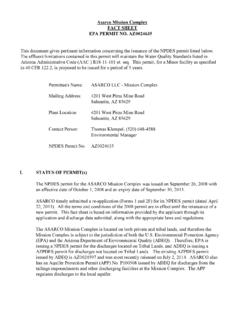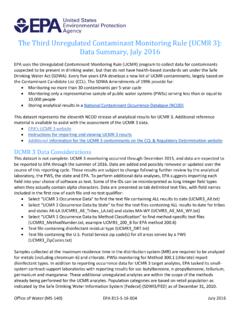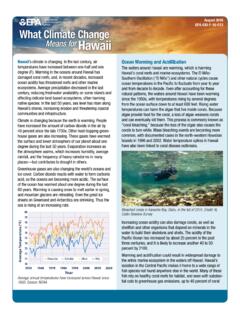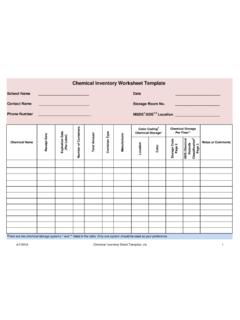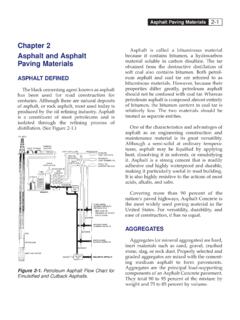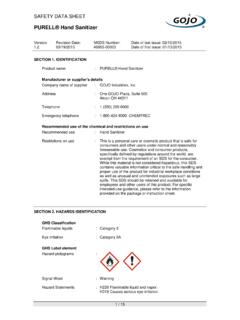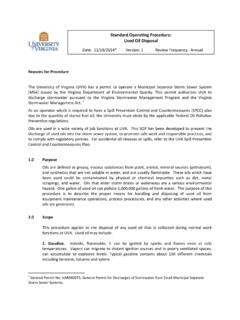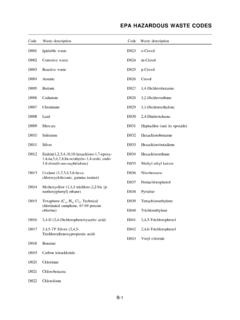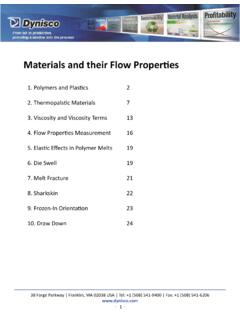Transcription of Definition of Solid Waste and Recycling
1 Definition of Solid Waste and Recycling8/15/20142 Outline for the Definition of Solid Waste and Recycling Presentation Statutory Definition of Solid Waste Regulatory Definition of Solid Waste Solid Waste Exclusions Four Categories of Discarded Materials Classes of Secondary Materials Determining if Materials are Solid Wastes, When Recycled Mechanisms to Ensure Proper Recycling Specific Hazardous Waste Recycling Requirements8/15/20143 Statutory Definition of Solid WasteRCRA Section 1004(27) The term Solid Waste means any garbage, refuse, sludge from a Waste treatment plant, water supply treatment plant, or air pollution control facility and other discarded material , including Solid , liquid, semisolid, or contained gaseous material resulting from industrial, commercial, mining, and agriculturaloperations, and from community activities, but does not 8/15/20144 Regulatory Definition of Solid Waste40 CFR Any discarded material * that is:1) Abandoned, 2) Inherently- Waste -like, 3) Military munitions, or4) Recycled.
2 Does not include material that is: Excluded under (a). Granted a variance under and To determine if a material is a Solid Waste when recycled, you need to know the type of material and how it is being recycled (explained in more detail further on in this presentation). Note, this Definition is solely for the purposes of defining wastes that are hazardous for the purposes of implementing RCRA Subtitle C regulations (40 CFR (b)(1)).* The term material refers to hazardous secondary material throughout this Waste Exclusions40 CFR (a) Domestic sewage and mixtures of domestic sewage ( (a)(1)) Industrial point source discharges ( (a)(2)) Irrigation return flows ( (a)(3)) Certain radioactive secondary materials ( (a)(4)) In-situ mining materials ( (a)(5)) Pulping liquors ( (a)(6)) Spent sulfuric acid ( (a)(7)) Secondary materials reclaimed in a closed-loop process in tanks ( (a)(8)) Spent wood preservatives ( (a)(9)) Coke by-product wastes ( (a)(10)) Splash condenser dross residues ( (a)(11) Oil-bearing hazardous secondary materials generated and recycled within the petroleum refining industry ( (a)(12)) Excluded scrap metal ( (a)(13)) Shredded circuit boards ( (a)(14))8/15/20146 Solid Waste Exclusions(continued)40 CFR (a))
3 Pulping condensates derived from Kraft mill steam strippers ( (a)(15)) Comparable fuels or syngas fuels ( (a)(16)) Mineral processing spent materials being recycled ( (a)(17)) Petrochemical recovered oil ( (a)(18)) Spent caustic solutions from petroleum refining ( (a)(19)) Hazardous secondary materials used to make zinc fertilizers ( (a)(20)) Zinc fertilizers made from hazardous secondary materials ( (a)(21)) used cathode ray tubes (CRTs) ( (a)(22)) Hazardous secondary materials generated and reclaimed under the control of the generator ( (a)(2)(ii) and (a)(23)) Hazardous secondary materials transferred to another person for the purpose of reclamation ( (a)(24)) Hazardous secondary material exported and reclaimed in a foreign country ( (a)(25))8/15/20147 Four Categories of Discarded Materials1) Abandoned Materials2) Inherently Waste -like Materials3) Military Munitions4) Recycled Materials8/15/201481)Abandoned40 CFR (a)(2)(i) Disposed of.
4 Burned or Incinerated. Accumulated, stored, or treated before or in lieu of being abandoned by being disposed of, burned, or ) Inherently Waste -Like40 CFR (d) Dioxin-containing listed wastes F020, F022, F023, F026, and F028. Secondary materials that are characteristic or listed hazardous Waste and fed to a halogen acid furnace. Criteria for listing as inherently Waste -like Disposed of, burned or incinerated. Contains hazardous constituents ( ) not normally found in the raw material and not used /reused during Recycling . May pose a substantial hazard to human health and the environment when ) Military Munitions40 CFR Military munitions are not Solid wastes when: used for their intended purpose ( , lead shot). Recycled ( , reused, repaired). Military munitions are Solid wastes when: Unused munitions Disposed of, removed from storage, deteriorated, declared a Solid Waste .
5 used munitions Retrieved & disposed of on-site or sent off-site for treatment or ) Recycled Materials40 CFR (c) used in a manner constituting disposal. Burned for energy recovery or used as a fuel. Reclaimed. Constituting Disposal (UCD)40 CFR (c)(1) Applying a material directly to the land. Using a material as an ingredient in a product that will be applied to the land. All materials that are UCD are Solid wastes, except commercial chemical products that are ordinarily applied to the For Energy Recovery40 CFR (c)(2) Burning a material directly as a fuel. Using a material as an ingredient in producing a fuel. The material is contained in a fuel. All materials burned for energy recovery are Solid wastes, except commercial chemical products that are ordinarily CFR (c)(3) Processing to recover a usable product. Wastes are processed to recover usable products when distinct components of the material that are of value are recovered.
6 Regeneration Wastes are regenerated when they are processed to remove contaminants in a way that restores them to their usable original (continued) Some materials being reclaimed are Solid wastes, some aren t Spent materials, listed sludges, & listed by-products are Solid wasteswhen reclaimed.* Characteristic sludges, characteristic by-products, and commercial chemical products being reclaimed are not Solid wastes. Scrap metal (other than excluded scrap metal see (c)(9)) when reclaimed is a Solid Waste .*Note, these materials may be excluded under (a)(2)(ii), (a)(23), (a)(24), or (a)(25) if the state has adopted these Solid Waste Exclusions40 CFR (e) Directly using or reusing a material : As an ingredient in an industrial process, As an effective substitute for a commercial chemical product, In the original process from which it was generated.
7 Materials must be used , reused, or returned to original process directly without first being reclaimed to qualify for this exclusion from being a Solid Waste . These exclusions do not apply to materials used in a manner constituting disposal or burned for energy recovery. 8/15/201417 Classes of Secondary Materials Spent Materials Sludges By-products Commercial Chemical Products Scrap Metal8/15/201418 Spent material Any material that has been used and, as a result of contamination, can no longer serve its intended purpose without undergoing regeneration, reclamation or reprocessing. Spent solvents Spent catalysts Spent pickle liquor Spent plating bath solutions8/15/201419 Sludge any Solid , semisolid, or liquid Waste generated from a municipal, commercial, or industrial wastewater treatment plant, water supply treatment plant, or air pollution control facility exclusive of the treated effluent from a wastewater treatment plant Wastewater treatment plant sludges Electric arc furnace dust (K061) Baghouse dusts8/15/201420By-Product a material that is not one of the primary products of a production process and is not solely or separately produced by the production process.
8 Distillation column bottoms Heavy ends Slag8/15/201421Co-Product A material intentionally produced by the manufacturing process and ordinarily used in its existing state as a commodity in trade by the general public. Co-products must have a recognized use, and must be usable without differ from Co-ProductsBy-Product:Co-Product:Residua l in processedNot intentionally producedIntentionally producedNot separately producedOrdinarily used as a commodityNeeds further processingNo further processing necessaryExample from a Metal Refining Process:CopperProduct LeadCo-productSlagBy-product8/15/201423 Commercial Chemical Product Unused product ( , off-specification chemical) Hazardous if 1) listed in (P and U wastes), or 2) exhibit a hazardous Waste characteristic8/15/201424 Scrap Metal bits and pieces of metal parts ..or metal pieces that may be combined together with bolts or soldering.
9 Which when worn or superfluous can be recycled. Sheet metal Wire Metal tanks and containers Scrap automobiles Machine shop turnings8/15/201425 Determining if Materials are Solid Wastes, When RecycledTable 1 of 40 CFR (c)UCDBFER eclamation*Speculative AccumulationSpent MaterialSWSWSWSWL isted SludgeSWSWSWSWC haracteristic SludgeSWSW---SWListed By-productSWSWSWSWC haracteristic By-productSWSW---SWCommercial Chemical ProductSWSW------Scrap MetalSWSWSWSW*Except as provided in (a)(2)(ii), (a)(17), (a)(23), (a)(24), or (a)(25).8/15/201426 Mechanisms to Ensure Proper Recycling Documentation of claims that materials are not Solid wastes ( (f)). Demonstrate the presence of a known market. Demonstrate the material is not a Waste or is exempt from regulation ( , they meet the conditions of the exclusion or exemption). Must show appropriate documentation ( , contracts) to demonstrate the material is not a Solid Waste Recyclers/reclaimers must show they have the necessary equipment to recycle the to Ensure Proper Recycling Speculative accumulation ( (c)(8)) Materials are not Solid Waste if: Recycling must be feasible.
10 75% of material stored at the beginning of the year must actually be recycled or sent for Recycling by the end of the year. If materials are speculatively accumulated, they are Solid wastes. Speculative accumulation does not apply to commercial chemical to Ensure Proper RecyclingFactors for Demonstrating Legitimate Recycling vs. Sham Recycling * Legitimate Recycling must involve a material that provides a useful contribution to the Recycling process or product Legitimate Recycling must produce a product or intermediate that is valuable The generator and recycler should manage the material as a valuable commodity The product of Recycling should not contain significant concentrations of hazardous constituents that are not found in analogous products ( , Toxics-Along-for-the-Ride or TARs)*Codified at 40 CFR for specific exclusions but substantially the same as existing policy for defining legitimate Hazardous Waste Recycling Requirements40 CFR (a)(2) Recyclable materials used in a manner constituting disposal: 40 CFR Part 266, Subpart C Hazardous wastes burned for energy recovery in boilers and industrial furnaces.
